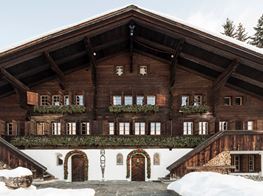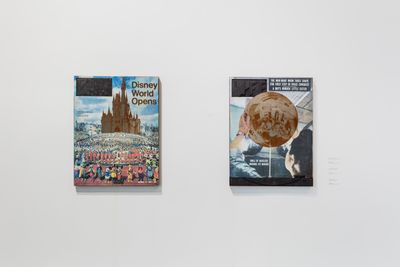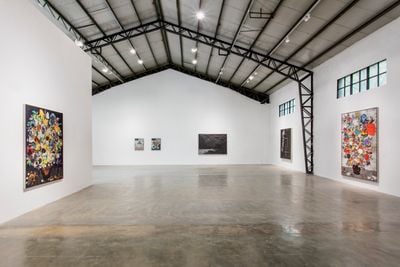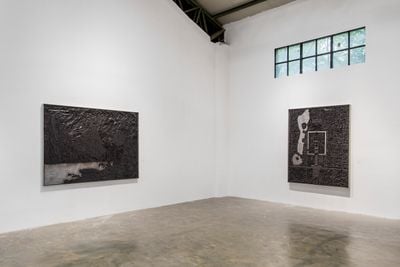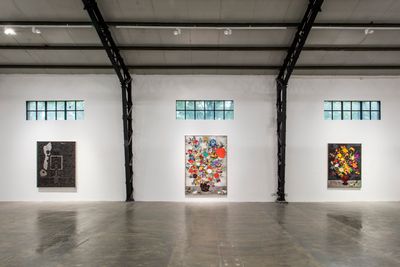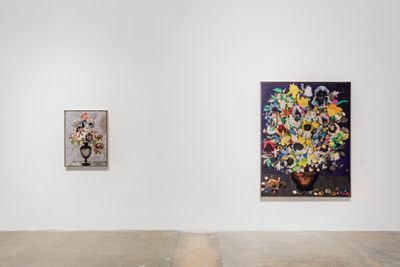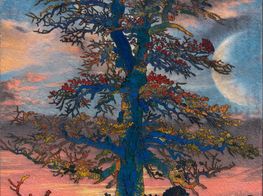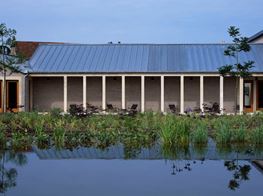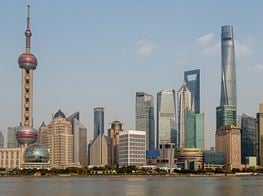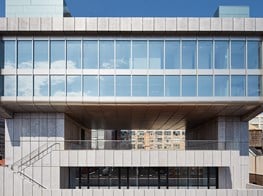Matthew Day Jackson
Matthew Day Jackson. Courtesy Hauser & Wirth. Photo: JJYPHOTO.
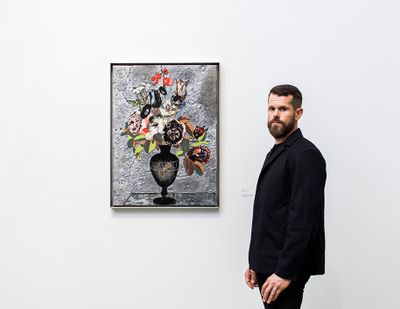
Matthew Day Jackson. Courtesy Hauser & Wirth. Photo: JJYPHOTO.
A charred and reflective post-apocalyptic scene looms large in the entrance to Qiao Space in Shanghai. On a sheet of mirror, a cone-shaped architectural structure is etched on the surface, referencing Pieter Bruegel the Elder's The Tower of Babel (1563), rising like a utopian Brigadoon out of the ashes of a scorched recomposed landscape. Pieced together like bits of black Lego are little village houses made of charred wood, while in the foreground a cluster of collaged figures plucked out of the same Bruegel painting busily get on with their drama against this brutal landscape of ruins—carrying on with work and maintaining hierarchy despite the devastation all around. It speaks of the futility and vanity of humanity's endeavours. Viewers can see themselves reflected back in the work, seduced by the scale, dazzle, and destruction.
This allegorical work, Babel (2013), draws on the traditions of both landscape and figurative painting. It is the centrepiece in an exhibition of mixed-media 'paintings' from American artist Matthew Day Jackson's first solo presentation in China, New Landscape (7 November 2018–21 January 2019), which features 11 works from 2013 to 2018 that highlight an interest in the landscape genre and its history, while exploring the mythical, the historical, and contemporary cityscape. References to contemporary political and social issues are also woven in, from environmental concerns to visible rising populism, and American culture.
Day Jackson's is a multifaceted practice, encompassing sculpture, paintings, printing, collage, photography, video, installation, and performance. His work traverses histories while repurposing symbols of American culture, such as Disney figures, atomic bombs, and Life magazine covers. Graduating with an MFA from Mason Gross School of the Arts at Rutgers University in 2001, California-born New York-based Day Jackson has explored the myth of the American Dream, and its violence-infected culture, for almost two decades. His works often convey both beauty and horror using a juxtaposition of materials such as his 'Gunshot Plywood Bronze' sculptures (2017) cast from plywood—a functional material used in housing—and bronze, a material used in memorial sculptures, to comment on gun violence in America. Or his sculptures Odalisque (with Thistles) I, II, and IV (2018) in the exhibition Still Life and the Reclining Nude at Hauser & Wirth in London (28 February–28 April 2018), a series of bronze reclining nudes cast from broken and rotting branches and other reclaimed detritus, projecting the human figure into nature while also examining the construction and reconstruction of identity through the physical form.
The collaged textured surfaces of his works—created through a layering of processes—display a convergence of materials and overload of visual references from news, pop culture, and history, resulting in a coded visual language that asks viewers to question and create meaning. Several of the 'paintings' in his Qiao Space exhibition are sculptural as much as they are painterly: brightly coloured floral arrangements composed of silkscreen and manufactured materials like Formica, plywood, lead on wood, and epoxy resin. They reference the 16th- and 17th-century paintings of Flemish Baroque painters Jan Bruegel the Elder and Jan Bruegel the Younger: cut and arranged flowers that are reminders of death even as they celebrate life, which were created when the Dutch Republic was reaching its height of colonial expansion. Grown in hothouses and composed of industrial materials like lead (a material associated with poisoning and death) and Formica, Day Jackson's contemporary floral works speak of how the use of technology for advancement and destruction affects nature and the environment. Visual references to nuclear test sites are embedded in flower petals.
In this conversation, Day Jackson discusses New Landscape, which explores forces of creation, destruction, and control, while grappling with his own political disillusionment.
DdYou work seems to exist in this liminal space between destruction and rebirth. There's a sense of transformation, with many works expressing a sense of foreboding while remaining hopeful.
MDJThank you, that's a really nice thing to say. I think when I'm showing my work in the States it's seen to mean one thing and that spectrum becomes narrower. When I've shown outside of the U.S. people are more available—it isn't seen as all darkness, and everything's fucked, and we're going to die, which we are. I think there's a political position from the standpoint that I believe everything is new and that nothing's ever been done. So, in that general belief, the thing that changes is authenticity, it's measured in tiny increments, and my job is to be as sensitive and open as possible to see those differences.
I think that in essence, an artist tries to take something that we've seen a million times and make it new again, such as the familiar narrative of falling in love, or hate, or whatever it is that as human beings we're constantly enacting. In terms of something being dark and light, these polarities are very much alive in my work. What I'm interested in is collision. I don't want to model these things, I want the viewer to do the modelling, to shape their own meaning.
DdThis idea of collision is embodied in Babel, in terms of the forces that meet in the work— dystopia and utopia, destruction and regeneration.
MDJYou know, I've never shown Babel before. I made it in 2013 and because of its size and scale, I only put it up once to photograph it. Having it shown here, where I've never been, and having all these people see it has been really great. From a distance it asks you to come closer, and as you come closer the materials begin to reveal themselves, and as they reveal themselves there's a certain uncanny space.
Some people won't know the references, and that's fine. But in my work I feel dutiful about it. There will be a spectrum of viewers that engage with it, from those who understand the references from Western painting to those who've never seen the reference. And I love the potential to bring that knowledge to an audience.
DdThis is your first show in China.
MDJFirst time in China. Growing up we didn't have the money to travel or anything. My partner Laura forced me to get a passport when I was 29 years old. I moved to New York basically as the equivalent of a ski bum, but I was an art bum. I was broke, and never had the opportunity to travel.
DdYour work contains art historical references, from Bruegel to memento mori, along with American cultural symbols. There is a lot of reading between the lines; a lot of political subtext. You make these critical statements, but at the same time your work can simply be read as beautiful.
MDJIn the end it's an object that I want people to engage with. That's what I'm shooting for. Growing up I just wanted to do a good job. Earlier on I wanted to make work the way I knew how to make art, which was for my family. My grandfather was a woodworker and self-trained photographer but also a police officer, and my mom can make almost anything, fabric things. She tailored shirts for my father and me, and that's really hard. And very beautiful quilt-making. We've actually collaborated on a bunch of things.
Going through art school, I just gravitated towards things that showed I was doing a good job. Fortunately, I freed myself from that and understood that in making something that's really purposeful, I can steer clear to a certain degree of irony. When I was younger there was a certain posturing with artists that I wasn't good at. I never really knew what the work was about. I knew what it didn't want to be, but what did it want to be? That was hard. Growing up around fairly religious people, it was a matter of defining who I was.
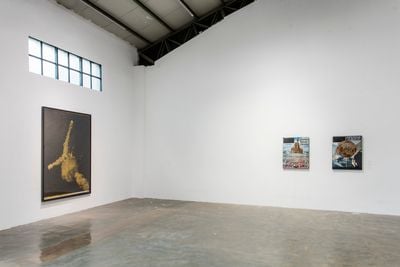
DdYou're using art as a space to claim a little bit of control over the narrative or how the narrative should be.
MDJGoing back to a thing that's really American is that what I'm about to say is really hopeful and based on the power of the individual. I think the world is made by creative people and artists, and I think that's a really powerful position. Maybe it's not in a painting, or maybe it's in a lot of paintings—it's like Joseph Beuys' idea that everyone is an artist.
For me, being an artist is a way of reclaiming my education. And the beautiful thing about being an artist is that it's a place in which there are a lot of different paths of research, knowledge, and interests that can converge. My understanding of the end of the American Civil War is where the deep racist history of the United States finds itself constantly being articulated now with people who support Donald Trump. For some people, it's not really about him, but about a higher authority. For others it's a platform, a space to have these fucked up ideas. At the same time, some people see in him their last chance to not be at the bottom—they have this idea that tomorrow will be 0.5 percent better than today or whatever. The disengagement with progress has left people denuded of that possibility of tomorrow.
DdThe flipside is that now, particularly in the United States, there's more of an engagement with the political process on a wider civic level. It's a critical moment to express yourself artistically too.
MDJI always thought that being an artist is a political gesture. It would defeat one's imagination to really describe what that means. Being an American artist, our culture doesn't care if you're an artist. The only time they care if you're an artist is if your rotting corpse is stinking up a building.
DdYou feel that there is no value in being an artist?
MDJWell, aside from market value, and that's just an unfortunate limitation of grasping for a metric to understand something. But, yeah, art is always political. When I was in the Skowhegan School of Painting and Sculpture in 2002, Amy Goodman talked to us after 9/11, when George Bush was in office. We were trying to figure out what to do; making a painting about something just felt like the wrong thing to do. She said: well what are you going to do? Become a politician? No, you sharpen your tools. Make them work better.
DdThere's this playful relationship between process and material in your work, too. When you're making something out of plywood, a material associated with the domestic environment, with housing and shelter, and then using a shotgun to 'sculpt' it as a critique of violence in American culture, such as the 'Gunshot Plywood Bronze' series (2017).
MDJThose pieces you reference were devastating pieces to make. They contain interplays between the public and the private, and the micro and the macro. The shotgun work goes back to Amy Goodman, when I was thinking about what to do. Being in Wyoming at the time, I felt I had to use the thing I was critical of to make a point. So, 850 rounds later, I got a huge bruise [from the recoil of the shooting] that was scabbed. To do it over and over again was flagellatory, not to be a monk but for meditative purposes.
DdThere's this idea in your work of communing with nature, while also controlling, shaping, or destroying it through technology. Technology can destroy society as much as it can advance it.
MDJI think we forget that everything we know, use, eat, and so on, comes from inside our atmosphere—except if there's a really big iron meteorite. Babel, which is shown in the front, contains all of the processes and materials that you see present in individual works in the show. If you're to look closely at Little Bouquet in Clay Jar (2018), the flowers aren't really flowers anymore. Within this petal, for example, there is an aerial view of the Trinity test site—it represents about a quarter mile. What you're looking at is basically glass. When they detonated the nuclear gadget, it baked a layer of the desert floor into what they call trinitite, which is a crude silica. I think at that point, when the weapon was detonated and released a new isotope into our atmosphere that had never been present before, that point was a new moment in time. If you think about how Babel was made from the same material as those two paintings, the job of the apocalypse or the reckoning is the job of a god or deity, but in the 20th century, it became a human possibility.—[O]

